Properties of Carbon
Carbon 是一種廣泛出現在自然界的元素,可以用於創造複雜的 macromolecules,如 DNA, RNA, sugars, fats 等。只要是由 carbon 和 hydrogen 組成的 organic molecules 都稱作 hydrocarbon,他們的 covalent bonds 可以儲存大量的 energy,使得 hydrocarbons 成為一種理想的燃料來源。Isomer 則是指 molecular formula 相同,但架構不同的 molecules,可以分成 structural isomers 和 stereoisomers 兩種。
Carbon
- Carbon 不只常出現在生活中 (pencil, briquettes, diamonds)
- Carbon 更在身體裡佔了 18% 的重量
- backbone of many important molecules (DNA, RNA, sugars, fats)
- 這些複雜的 biological molecules 又稱作 marcomolecules (organic molecules)
- 因為他們都包含 carbon atoms
The bonding properties of carbon
- 因為 carbon-carbon bonds 非常的堅固,所以適合當作 molecular backbones
- 另外 carbon 也有很大的 covalent bonding capacity
- Carbon atom 的原子序為 6 (代表在 neutral 時有 6 protons 和 6 electrons)
- 6 electrons 分別有 2 個在 inner shell,而 4 個在 valence (outermost) shell
- 所以 carbon atom 只有 4 個 valence electron ,還有 4 個空間可以和其他 atom 作用
- 舉個例子,在 methane 中,carbon 和 4 個 hydrogen 產生 covalent bonds
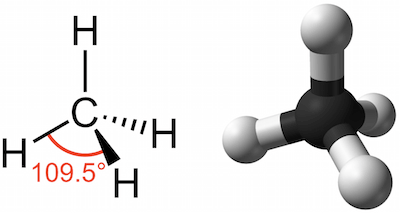
Hydrocarbons
只要是全由 carbon 和 hydrogen 組成的 organic molecules 都會稱作 hydrocarbon
- 上面例子所舉的 methane 就是一種 hydrocarbon
在生活中有許多 hydrocarbon 的例子
- propane 應用於燒烤
- butane 應用於打火機
看起來都是非常好的燃料來源
- 原因是 hydrocarbon 的 covalent bonds 可以儲存大量 energy
- 透過燃燒來釋放能量 (react with oxygen to form and water)
通常由一個 carbon atom 和四個其他 atoms 所組成的 molecules 都會形成 tetrahedral 的形狀
- 由 carbon 在正中央,而四個 atoms 向四個完全不同方向散射出去
- tetrahedral shape = 4 triangular faces
- 例如 methane
這是因為生成 bonds 的 electron pairs 互相排斥彼此
- 所以 pairs 間的 distance 都拉到最遠的距離,形成這樣四面體的形狀
大多數的 marcomolecules 不是 hydrocarbons
- 因為他們雖然有包含 carbon, hydrogen
- 但還和很多不同的 atoms 組合在一起 (e.g., nitrogen, oxygen, phosphorus)
但注意 carbon chain with attached hydrogens 是大多數 marcomolecules 的 key component
- 所以了解 hydrocarbons 的 properties 能更了解 macromolecules 的 behaviors
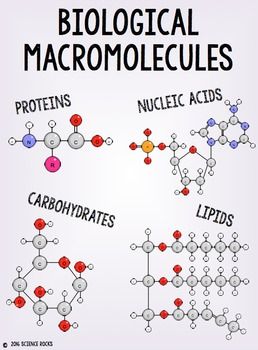
Representing structures of organic molecules
- 以下是幾種方式來表達 organic molecules 的架構
- 通常會用直線而不用兩點來表達 covalent bonds
- 也可以簡寫成單字 subscript 數量
- 甚至使用直線直接表達 carbon chain
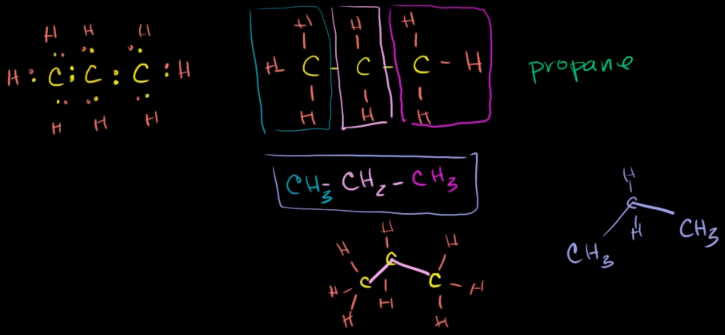
Hydrocarbon structures and functional groups
- gasoline 當中的 hydrocarbons 可以有 4 至 12 的 carbon atoms
- 這些的 hydrocarbons 有的是 straight line,有的是 branched structure
- 有的 carbon-carbon bonds 是 single bonds 有的是 double, triple bonds
- 還有 ring 狀的架構
- 在 gasoline 的這些不同 hydrocarbons 都會有不一樣的 properties (melting, boiling points)
Hydrocarbons are diverse
- 單看 gasoline 的例子就可以知道 hydrocarbons 的多樣性
- differ in length, branched or unbranched, linear or ring shape
- single, double, triple carbon-carbon bonds
- 會有相同的 molecular formula 但是完全不同的架構,稱作 isomer
- 這些不同的改變使得 hydrocarbons 的 3D shape (molecular geometry) 有所不同
- 在人體中也影響了 DNA, proteins 等 biological molecules 的運作
Branching, multiple bonds, and rings in hydrocarbons
Hydrocarbon 的主要部分為 carbon atoms 所組成的 carbon chain
- Chains 可長可短
- e.g., ethane 包含 2 個 carbons,而 decane 包含 10 個 carbons
這些 chain 不一定是一條線,有可能是任何形狀
- e.g., decane 的 10 carbons 連成一條線
- 但有其他相同 molecular formula 的 hydrocarbons 是含有 branches 的
- 實際上, 共有 75 種可能的架構
Hydrocarbons 還有各種不同的 carbon-carbon bonds (single, double, triple)
- 分別為 ethane, ethene, ethyne
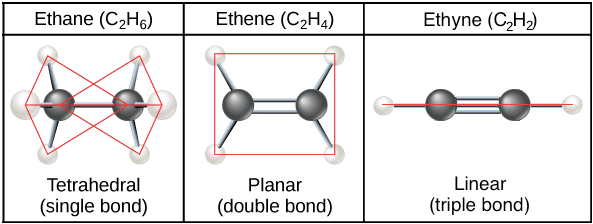
Ethane
- C 和 C 是 single bond
- 有著 2 個 tetrahedron shape (1 個 carbon 為 1 個核心)
- 重點是可以兩個 tetrahedron 可以旋轉
Ethene
- C 和 C 是 double bond (所有的 atoms 都在同個平面)
- 跟 single bond 不同,double bond 的 molecules 是無法旋轉的 !
Ethyne
- C 和 C 是 triple bond
- 和 ethene 一樣無法旋轉
Hydrocarbon 也包含多種 ring structure
- 也就是 carbon 之間形成一個 cycle
- carbon 間允許有 branches 和 double bonds
有些 rings with conjugated atoms 非常 stable
- 這些 ring 又稱作 aromatic rings
- 常在 amino acids (e.g., hormones, testosterone, estrogens) 看見

Isomers
- Hydrocarbon 的架構 (molecular geometries) 會直接影響 physical, chemical properties
- 有相同的 molecular formula 但又不同架構的 molecules 稱作 isomers
- isomer 又可以分成 structural isomers 還有 stereoisomers
Structural isomers
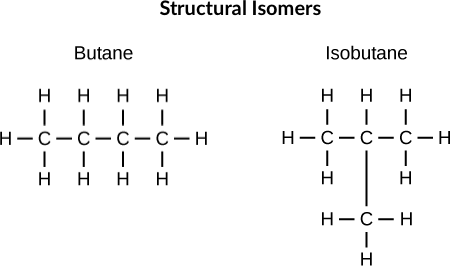
- Atoms 的連結方式完全不同
- 例如上圖的 butane 和 isobutane 都是 4 carbons + 10 hydrogens
- 但有 butane 是 linear
- 而 isobutane 是 branched
- 所以他們兩個的 melting, boiling points 是完全不同的
- butane 適合用作 ligter, torch 的燃料
- isobutane 用作 refrigerant, spray cans 的 propellant
Stereoisomers
- Atoms 的連結方式一模一樣,但是方向完全相反
- Stereoisomers 可以分成兩種 : enantiomers 和 diastereomers
- Enantiomers 就像 mirror image,enantiomers 間是不可以疊加在一起的
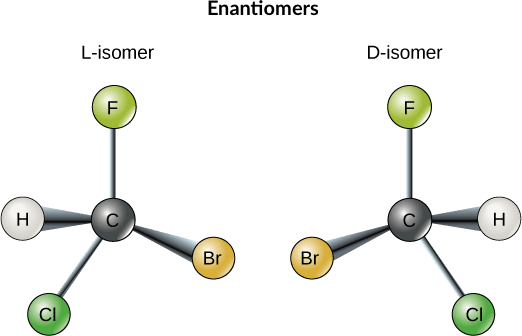
- 上圖是一組 enantiomer pair
- 兩者都有相同的 molecular formula 且都是由 fluorine, bromine, hydrogen 和 carbon bond 在一起所組成
- 但兩者是鏡像成對,就像左右手一樣是不能完美疊在一起的
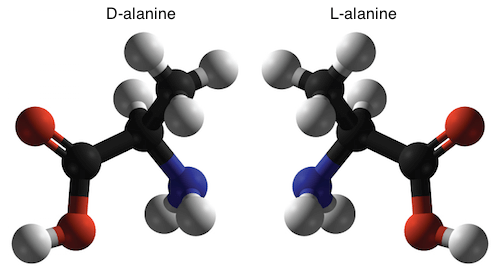
大多數的 amino acids (用於組成 proteins)
- 都包含了 asynmmetric carbon
- 上圖就是一個包含 2 個 enantiomers 的 amino acid alanine
- 在 biology 中,通常會用 L/D prefix 來命名兩者
- 但更精確應該用 R/S 來命名
雖然 enantiomers 間看起來非常像,但一對 enantiomers 對生物的影響非常非常不同
- 例如 D form of ethambutol 可以製成藥片治療 tuberculosis (肺結核)
- 但是 L form 卻可以致盲
又或者某些 enantiomers 只有其中一邊出現在身體中
- L form of amino acids 用於生產 proteins (但 D form 不常見)
- D form of sugar glucose 是 photosynthesis 的主要產物 (但 L 幾乎不會出現在自然界)
其他不是 enantiomers 的 stereoisomers 就是 diastereomers
- cis-trans isomer 是一個經典的 diastereomer
- 發生於 atom 或 functional group 錯位在 carbon-carbon double bond 的兩邊
- 因為 double bond 無法旋轉的關係,導致他們的架構不同
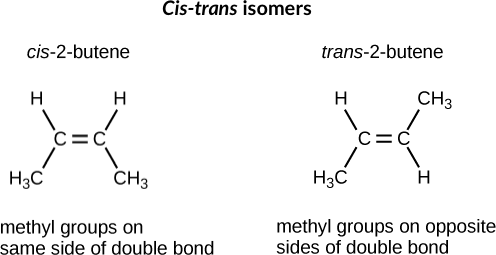
- 例如 2-butene 中的 2 個 methyl groups
- 若都在同一邊,稱作 cis configuration of 2-butene
- 若在相反邊,稱作 trans configuration
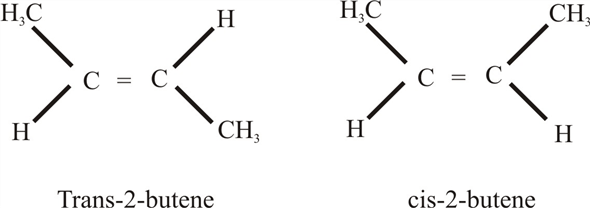
在 trans configuration 中 carbon backbone 大多是 linear 的
而 cis configuration 中 backbone 多為 bend, kick 的
fatty acids (脂肪酸) 通常包含 double bonds
- 也就會有 cis / trans configuration
Cis fatty acids 在室溫下通常為正常的 oils
- 因為 backbone 是 bend 的關係,讓 molecules 不會被 pack tightly together
Trans fatty acids (trans fatty, 反式脂肪) 在室溫下則為固態的脂肪
- 因為 backbone 相對 linear 關係,molecules pack tightly together
Functional Group
Hydrocarbons 很適合作為 combustion fuels 使用
- 但要組成 living organism 似乎還不夠
大部份的 biological molecules 包含非常多 carbon, hydrogen 以外的 atoms
- 這些 atoms 能夠給予更多樣性的 functionality
大多的 biological molecules 由 carbon skeleton 和其他 atoms (oxygen, nitrogen, sulfur, etc) 組成
- 這些"其他 atoms" 通常會以 functional groups 角色出現
- functional groups 是一些 atoms 組成的 pattern, motif
- functional groups 會表示出一致的 function (properties, reactivity)
- 所以 biological molecules = carbon skeleton + many different functional groups
最常見的 functional groups 在下表列出
- 其中 methyl group 是 hydrophobic (nonpolar)
- 而其他六種 functional groups 皆為 hydrophilic (polar)
| Functional Group | Structure | Properties |
|---|---|---|
| Hydroxyl | Polar | |
| Methyl | Nonpolar | |
| Carbonyl | Polar | |
| Carboxyl | Polar, Acidic | |
| Amino | Polar, Basic | |
| Phosphate | Polar, Acidic | |
| Sulfhydryl | Polar |
Carboxyl group 是一個非常 hydrophilic 的 functional group
- 可以失去一個 proton 來形成負電的 carboxylate ion
- 所以他除了 polar 還是酸性
- 通常可以在 amino acids, fatty acids 等 biomolecules 看到他
Carbonyl group 則是 less hydrophilic 的 functional group
- 他是 uncharged 但有 partial positive/negative charges 所以 polar
- 通常可以在 proteins, peptides, carbohydrates 等地方看到他
在表中可以看到 letter R 用來表達一大串的 molecules
- R 可能是 ethyl group
- 可以跟第一個 entry 形成 ethanol
- R 也可能拿來表達非常大的 molecule (e.g., protein)
- R 的用法會在 biology, chemistry 常見到
- 用來簡化 chemical structures 並只強調重要的部分 (通常為 functional groups !)
- R 可能是 ethyl group